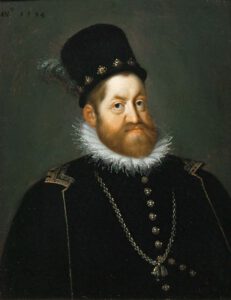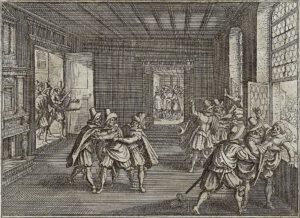Scotland and the 30-year war

Prehistory
Emperor Rudolf II., King of Bohemia and Hungary, issued in 1609 two Deed´s (known as Majesty Letter) in which the protestant Estates were granted religious freedom.
In addition to the free exercise of Religion was also the establishment of a protestant Church Organization, and the construction of protestant Churches not only in Areas of the Nobility, but also on the possessions of Emperor, King and Prince assured.
Since it was not certain whether the Areas of the catholic conventual´s must allow the construction of protestant Churches, there were always Disputes.
Beginning of the Thirty Years’ War

In 1617, the Protestants accused their predominantly catholic Rulers of not adhering to the granted religious Freedom.
When then the Estates Assembly was dissolved, the Indignation was great. On May 23, 1618 almost 200 representatives of the Protestants under the Leadership of Heinrich Thurn moved to Prague Castle, held an impromptu show trial and threw the Governors Jaroslaw Borsita, Wilhelm Slavata and the secretary Philipp Fabricius from 17 meters high through the window in the Moat (Prague Lintel), although all three injured on the Head, but survived.
Triggered by this “Lintel” the bohemian Protestants began an Uprising against the attempts to recatholicize of the bohemian King and culminated in a Religious War, which was terminated only on 24 October by the Peace of Westphalia.
Scottish Participation
In 1613, Elizabeth Stuart, Daughter of James VI. (James I. of England) married Frederick V. of the Palatinate.
After Emperor Maximilian invaded for the catholic League in the Palatinate, Frederick was forced to join in the fighting and asked James VI. as his Father-in-Law for help. Under the Army that James sent to the Palatinate, it was proven that there were 3,000 Scots led by Sir Andrew Grey, known for their Fighting Spirit and Loyalty. The Scots were armed with the typical Longswords and Bows and Arrows, but occasionally there were also Muskets.
Due to the Language Barrier, the Scots remained mostly among themselves, but some Squad Leaders command the german Language, so that Orders could be transmitted and followed. Through this Language Barrier arose a great cohesion among the Scots, due to which neither Wounded nor Dead remained on the Battlefield.
Their motto was “Scotland and Infantry First”, which is also found in today’s Scots Guards.
From this time also comes the oldest known Illustration of the Highlander in the Belted Plaid (see History of the Kilt).
Another Illustration can be found in the franconian Waigolshausen. When the local Church was renovated there was found under the old Plaster a “Graffiti” which shows a scottish Piper in the Belted Plaid.